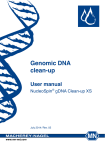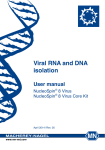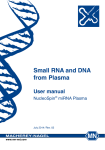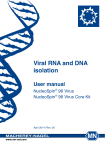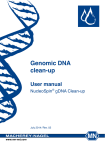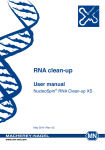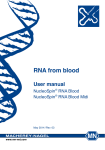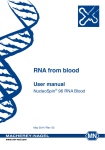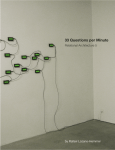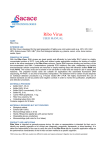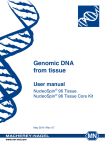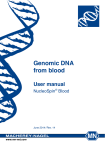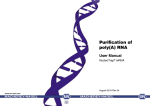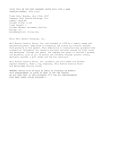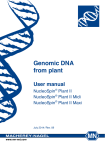Download Viral RNA isolation - MACHEREY
Transcript
Viral RNA isolation User manual NucleoSpin® RNA Virus NucleoSpin® RNA Virus F July 2014 / Rev. 11 Viral RNA isolation Protocol-at-a-glance (Rev. 11) 1 2 3 4 5 Lysis of viruses Adjust binding conditions Mini Funnel NucleoSpin® RNA Virus NucleoSpin® RNA Virus F 150 μL sample volume 1 mL sample volume 600 μL RAV1 4 mL RAV1 70 °C, 5 min 70 °C, 5 min 600 μL ethanol 4 mL ethanol Load sample stepwise Load sample 8,000 x g, 1 min 3,000 x g, 3–5 min Bind viral RNA Wash and dry silica membrane Elute highly pure RNA 1st wash 500 μL RAW 1st wash 5 mL RAW 2nd wash 600 μL RAV3 2nd wash 8 mL RAV3 3rd wash 200 μL RAV3 3rd wash 2 mL RAV3 1st and 2nd 8,000 x g, 1 min 1st and 2nd 3,000 x g, 3 min 3rd 11,000 x g, 5 min 3rd 3,000 x g, 10 min 50 μL RNase-free H2O (70 °C) 50–100 μL RNase-free H2O (70 °C) RT, 1–2 min RT, 1–2 min 11,000 x g, 1 min 3,000 x g, 3 min MACHEREY-NAGEL GmbH & Co. KG · Neumann-Neander-Str. 6–8 · 52355 Düren · Germany Tel.: +49 24 21 969-270 · Fax: +49 24 21 969-199 · [email protected] · www.mn-net.com Viral RNA isolation Table of contents 1 Components 4 1.1 Kit contents 4 1.2 Reagents, consumables, and equipment to be supplied by user 6 1.3 About this user manual 6 2 Product description 7 2.1 The basic principle 7 2.2 Kit specifications 7 2.3 Remarks regarding sample quality and preparation 8 2.4 Remarks regarding elution 10 2.5 Remarks regarding quality control 10 3 Storage conditions and preparation of working solutions 11 4 Safety instructions 13 5NucleoSpin® RNA Virus protocols 15 5.1 Viral RNA isolation from cell-free biological fluids 15 5.2 Isolation of viral RNA and DNA from cell-free biological fluids 17 6NucleoSpin® RNA Virus F protocols 18 6.1 Viral RNA isolation from cell-free biological fluids 18 6.2 Isolation of viral RNA and DNA from cell-free biological fluids 20 7Appendix 21 7.1Troubleshooting 21 7.2 Ordering information 22 7.3References 22 7.4 Product use restriction / warranty 23 MACHEREY-NAGEL – 07 / 2014, Rev. 11 3 Viral RNA isolation 1 Components 1.1 Kit contents NucleoSpin® RNA Virus 10 preps 50 preps 250 preps 740956.10 740956.50 740956.250 Lysis Buffer RAV1 10 mL 35 mL 5 x 35 mL Wash Buffer RAW 6 mL 30 mL 150 mL Wash Buffer RAV3 (Concentrate)* 6 mL 12 mL 50 mL RNase-free H2O 13 mL 13 mL 30 mL Elution Buffer RE** 13 mL 13 mL 30 mL Carrier RNA (lyophilized) 300 μg 1 mg 5 x 1 mg NucleoSpin® RNA Virus Columns (dark blue rings, plus Collection Tubes) 10 50 250 Collection Tubes (2 mL) 30 150 750 User manual 1 1 1 REF * For preparation of working solutions and storage conditions see section 3. **Composition of Elution Buffer RE: 5 mM Tris/HCl, pH 8.5 4 MACHEREY-NAGEL – 07 / 2014, Rev. 11 Viral RNA isolation 1.1 Kit contents continued NucleoSpin® RNA Virus F 25 preps REF 740958 Lysis Buffer RAV1 2 x 120 mL Wash Buffer RAW 150 mL Wash Buffer RAV3 (Concentrate)* 3 x 25 mL RNase-free H2O 13 mL Elution Buffer RE** 13 mL Carrier RNA (lyophilized) 2 x 300 μg NucleoSpin® RNA Virus F Columns (plus Collection Tubes) 25 Collection Tubes (50 mL) 25 Collection Tubes (0.5 mL) 25 User manual 1 * For preparation of working solutions and storage conditions see section 3. **Composition of Elution Buffer RE: 5 mM Tris/HCl, pH 8.5 MACHEREY-NAGEL – 07 / 2014, Rev. 11 5 Viral RNA isolation 1.2 Reagents, consumables, and equipment to be supplied by user Reagents • 96–100 % ethanol Consumables • • 1.5 mL microcentrifuge tubes (NucleoSpin® RNA Virus) or 50 mL tubes (NucleoSpin® RNA Virus F) Disposable tips Equipment • Manual pipettors • Vortex mixer • Personal protection equipment (lab coat, gloves, goggles) • • Centrifuge for microcentrifuge tubes (NucleoSpin® RNA Virus) or 50 mL tubes (NucleoSpin® RNA Virus F) Heating block or water bath for 70 °C incubation 1.3 About this user manual It is strongly recommended reading the detailed protocol sections of this user manual if the NucleoSpin® RNA Virus / RNA Virus F kit is used for the first time. Experienced users, however, may refer to the Protocol-at-a-glance instead. The Protocol-at-aglance is designed to be used only as a supplemental tool for quick referencing while performing the purification procedure. All technical literature is available on the internet at www.mn-net.com. Please contact Technical Service regarding information about changes of the current user manual compared to previous revisions. 6 MACHEREY-NAGEL – 07 / 2014, Rev. 11 Viral RNA isolation 2 Product description 2.1 The basic principle With the NucleoSpin® RNA Virus method, RNA viruses are lysed quickly and efficiently by Lysis Buffer RAV1 which is a highly concentrated solution of GITC. DNA viruses (e.g., HBV) are usually more difficult to lyse and require Proteinase K digestion (see support protocol, section 5.2). Lysis buffer and ethanol create appropriate conditions for binding of nucleic acids to the silica membrane of the NucleoSpin® RNA Virus Columns. Carrier RNA improves binding and recovery of low-concentrated viral RNA. Contaminations (potential PCR inhibitors) like salts, metabolites and soluble macromolecular cellular components are removed in simple washing steps with ethanolic buffers RAW and RAV3. The nucleic acids can be eluted in low salt buffer or water and are ready-for-use in subsequent reactions. 2.2 Kit specifications NucleoSpin® RNA Virus / Virus F kits are designed for the rapid preparation of highly pure viral nucleic acids (e.g., HCV, HIV, CMV) from fluid biological samples, for example plasma, serum, urine, but not blood (see remarks in section 2.1). • No cross contamination due to closed systems. • The NucleoSpin® RNA Virus kit works with 150 μL serum, NucleoSpin® RNA Virus F funnel columns allow the processing of 1 mL serum. • The funnel column of the NucleoSpin® RNA Virus F kit allows a high loading capacity as well as a simultaneously small elution volume. • The prepared nucleic acids are suitable for applications like automated fluorescent DNA sequencing, RT-PCR*, or any kind of enzymatic reaction. The detection limit for certain viruses depends on the individual procedures, for example in-house nested (RT-) PCR. We highly recommend using internal (low-copy) standards as well as positive and negative controls to monitor the purification, amplification, and detection processes. • Carrier RNA (poly(-A) RNA: poly(A) potassium salt, prepared from ADP with polynucleotide phosphorylase) is included for optimal performance. Carrier RNA enhances binding of viral nucleic acids to the silica membrane and reduces the risk of viral RNA degradation. Please note that eluates of the NucleoSpin® RNA Virus kit contain both viral nucleic acids and Carrier RNA with amounts of Carrier RNA that may exceed the amount of viral nucleic acids. Therefore, it is not possible to quantify the nucleic acids isolated with the kit by photometric or fluorometric methods when using the carrier. Thus, other methods for quantification such as specific quantitative PCR or RTPCR systems are recommended. Furthermore, Carrier RNA may inhibit PCR reactions. The amount of added Carrier RNA may thus be carefully optimized depending on the individual PCR system used. MACHEREY-NAGEL – 07 / 2014, Rev. 11 7 Viral RNA isolation Table 1: Kit specifications at a glance Parameter NucleoSpin® RNA Virus NucleoSpin® RNA Virus F Technology Silica-membrane technology Silica-membrane technology Format Mini spin columns Funnel columns ≤ 150 μL serum, plasma, cell-free biological fluids ≤ 1 mL serum, plasma, cell-free biological fluids 100 b–approx. 50 kb 100 b–approx. 50 kb > 90 % > 90 % 30–60 cp/mL* 30–60 cp/mL* 50 μL 50–100 μL Preparation time 30 min/4–6 preps 45 min/2–4 preps Binding capacity 40 μg 30 μg Sample material Fragment size Typical recovery rates Typical analysis limit Elution volume 2.3 Remarks regarding sample quality and preparation Liquid samples Biological fluids or semi-fluid samples can be processed (e.g., serum, urine, or bronchoalveolar lavage). For successful nucleic acid purification it is important to obtain a homogeneous, clear, and non-viscous sample before loading onto the NucleoSpin® RNA Virus Column. Therefore, check all samples (especially old or frozen ones) for presence of precipitates. Precipitates remaining after lysis with Buffer RAV1 can be removed by centrifugation. Avoid clearing samples before lysis, because viruses of interest may be associated with particles or aggregates. Incubation with Buffer RAV1 can be prolonged in order to dissolve and digest residual cell structures, precipitates and virus particles. RNA, however, is sensitive and prolonged incubation may cause decreased yields. Solid samples (tissue samples, stool samples) Prepare a 10 % (w / v) suspension of tissue in buffer (e.g., PBS) using commercial homogenization tools (rotor-stator or bead-based homogenization tools, etc.). Centrifuge the suspension in order to remove particles. Use the clear particle-free supernatant for further processing. * Nested PCR 8 MACHEREY-NAGEL – 07 / 2014, Rev. 11 Viral RNA isolation Swab material Incubate swab in a suitable buffer (e.g., PBS) or cell-culture medium for 30 min. Proceed with particle-free buffer or medium. Blood samples Processing of blood samples is possible if using blood diluted with PBS buffer. Using undiluted blood may cause clogging of the silica membrane of the NucleoSpin® Virus Binding Plate. The amount of PBS buffer added to blood samples has to be optimized for the individual organism. As a rule of thumb we recommend to start with 50 μL blood diluted with 50 μL PBS buffer. Proteinase K treatment Addition of Proteinase K solution (see ordering information) is necessary for the isolation of viral DNA or simultaneous viral RNA / DNA isolation. For isolation of viral RNA, Proteinase K treatment is usually not required. Proteinase K treatment is recommended for viral RNA isolation when viscous samples have to be processed (e.g., sputum samples). Sample lysis For isolation of viral RNA in general a lysis of samples in Buffer RAV1 for 10 min at room temperature (20–25 °C) will be sufficient. For isolation of viral RNA from viscous samples, for example sputum or supernatants of tissue suspensions or stool samples, a lysis at 70 °C may be required. For simultaneous isolation of viral RNA and DNA, incubation time (e.g., 5–15 min), and temperature (e.g., RT, 56 °C, or 70 °C) should be optimized and adjusted to the sample material used. MACHEREY-NAGEL – 07 / 2014, Rev. 11 9 Viral RNA isolation 2.4 Remarks regarding elution • Pure nucleic acids are finally eluted under low ionic strength conditions with RNase-free H2O (pH about 7–8) or slightly alkaline Buffer RE (5 mM Tris-HCl, pH 8.5). • Elution can be performed in a single step with water / elution buffer as indicated in the protocol, obtaining at least 80 % of the bound nucleic acids. To improve sensitivity, this eluate can be used in a second elution step increasing the efficiency of elution and concentration of viral nucleic acids slightly. Alternatively, a second elution step can be performed with an additional volume of water / elution buffer releasing practically all bound nucleic acids but resulting in a lower concentrated, combined eluate. • RNA should be eluted with the water supplied and DNA with Elution Buffer RE. Buffer RE provides better storage conditions for DNA. To elute both types of nucleic acids together, use the pH proofed (pH 6–8), RNase-free H2O preheated to 70 °C. 2.5 Remarks regarding quality control • 10 Buffers and NucleoSpin® RNA Virus / RNA Virus F Columns have been tested with rRNA and MS2 phage RNA. The absence of RNases, and the yield and efficiency of purification have been investigated with RT-PCR. MACHEREY-NAGEL – 07 / 2014, Rev. 11 Viral RNA isolation 3 Storage conditions and preparation of working solutions Attention: Buffers RAV1 and RAW contain chaotropic salts. Wear gloves and goggles! CAUTION: Buffer RAV1 contains guanidinium thiocyanate and Buffer RAW contains guanidine hydrochloride which can form highly reactive compounds when combined with bleach (sodium hypochlorite). DO NOT add bleach or acidic solutions directly to the sample-preparation waste. • All kit components can be stored at room temperature (18–25 °C) and are stable up to one year. • Carrier RNA has a limited shelf life in Buffer RAV1. For this reason, some kits contain several bottles of lyophilized Carrier RNA that should be used successively as required, to avoid degradation of Carrier RNA. Note: Due to the production procedure and the small amount of Carrier RNA contained in the vial, the carrier may hardly be visible in the vial. • Before use, add 1 mL Lysis Buffer RAV1 to the Carrier RNA tube. Dissolve the RNA and transfer it back to the RAV1 bottle. Storage of Carrier RNA in Buffer RAV1: • Lysis Buffer RAV1 including Carrier RNA can be stored at room temperature for 1–2 weeks. Storage at room temperature prevents salt precipitation. Lysis Buffer RAV1 including Carrier RNA can be stored at 4 °C for up to 4 weeks or aliquoted and stored at -20 °C for longer periods. Storage at 4 °C or below may cause salt precipitation. Therefore, the mixture must be preheated at 40–60 °C for a maximum of 5 min in order to redissolve salts. Do not warm Buffer RAV1 containing Carrier RNA more than 4 times! Frequent warming, temperatures > 80 °C, and extended heat incubation will accelerate the degradation of Carrier RNA. This leads to reduced recovery of viral RNA and eventually false negative RT-PCR results, in particular if low-titer samples are used. Before starting any NucleoSpin® RNA Virus / RNA Virus F protocol, prepare the following: • Wash Buffer RAV3: Add the indicated volume of ethanol (96–100 %) to Wash Buffer RAV3 Concentrate. Mark the label of the bottle to indicate that the ethanol is added. Store Wash Buffer RAV3 at room temperature (18–25 °C) for up to one year. MACHEREY-NAGEL – 07 / 2014, Rev. 11 11 Viral RNA isolation NucleoSpin® RNA Virus REF Wash Buffer RAV3 (Concentrate) 10 preps 50 preps 250 preps 740956.10 740956.50 740956.250 6 mL 12 mL 50 mL Add 24 mL ethanol Add 48 mL ethanol Add 200 mL ethanol NucleoSpin® RNA Virus F 25 preps REF Wash Buffer RAV3 (Concentrate) 12 740958 3 x 25 mL Add 100 mL ethanol to each vial MACHEREY-NAGEL – 07 / 2014, Rev. 11 Viral RNA isolation 4 Safety instructions The following components of the NucleoSpin® RNA Virus kits contain hazardous contents. Wear gloves and goggles and follow the safety instructions given in this section. GHS classification Only harmful features do not need to be labeled with H and P phrases up to 125 mL or 125 g. Mindergefährliche Eigenschaften müssen bis 125 mL oder 125 g nicht mit H- und P-Sätzen gekennzeichnet werden. Component Hazard contents GHS symbol Hazard Precaution phrases phrases Inhalt Gefahrstoff GHS Symbol H-Sätze P-Sätze RAV1 Guanidinium thiocyanate 30–60 % Warning Guanidiniumthiocyanat 30–60 % Achtung 302, 412, EUH031 260, 273, 301+312, 330 Guanidine hydrochloride 24–36 % + ethanol 3555 % Warning 226, 302 210, 233, 301+312, 330, 403+235 RAW Guanidinhydrochlorid 24–36 % + Ethanol 35–55 % Achtung Hazard phrases H 226 Flammable liquid and vapour. H 302 Harmful if swallowed. H 412 Harmful to aquatic life with long lasting effects. EUH031 Contact with acids liberates toxic gas. Flüssigkeit und Dampf entzündbar. Gesundheitsschädlich bei Verschlucken. Schädlich für Wasserorganismen, mit langfristiger Wirkung. Entwickelt bei Berührung mit Säure giftige Gase. Precaution phrases P 210 Keep away from heat, hot surfaces, sparks, open flames and other ignition sources. No smoking. Von Hitze, heißen Oberflächen, Funken, offenen Flammen sowie anderen Zündquellenarten fernhalten. Nicht rauchen. P 233 Keep container tightly closed P 260 Do not breathe vapours. P 273 Avoid release to the environment. Behälter dicht verschlossen halten. Dampf nicht einatmen. Freisetzung in die Umwelt vermeiden. MACHEREY-NAGEL – 07 / 2014, Rev. 11 13 Viral RNA isolation Precaution phrases P 301+312 IF SWALLOWED: Call a POISON CENTER/ doctor/…/if you feel unwell. P 330 Rinse mouth. P 403+235 Store in a well ventilated place. Keep cool. BEI VERSCHLUCKEN: Bei Unwohlsein GIFTINFORMATIONSZENTRUM / Arzt /… anrufen. Mund ausspülen. Kühl an einem gut belüfteten Ort aufbewahren. For further information please see Material Safety Data Sheets (www.mn-net.com). Weiterführende Informationen finden Sie in den Sicherheitsdatenblättern (www.mn-net.com). 14 MACHEREY-NAGEL – 07 / 2014, Rev. 11 NucleoSpin® RNA Virus 5 NucleoSpin® RNA Virus protocols 5.1 Viral RNA isolation from cell-free biological fluids Before starting the preparation: • • 1 Check if Lysis Buffer RAV1 and Wash Buffer RAV3 were prepared according to section 3. Preheat an aliquot of Elution Buffer RE / RNase-free H2O to 70 °C. Lysis of viruses Add 600 μL Buffer RAV1 containing Carrier RNA to 150 μL of the sample. Pipette mixture up and down and vortex well. Incubate for 5 min at 70 °C. Incubation time and temperature are critical for lysis as well as RNA stability (see troubleshooting for further hints, section 6.1). If the resulting solution is still turbid, centrifuge the mixture for 1 min at 11,000 x g (to pellet particles and to prevent clogging of the NucleoSpin® RNA Virus Columns). Take off the supernatant and proceed with step 2. 2 + 600 μL RAV1 70 °C, 5 min Adjust binding conditions Add 600 μL ethanol (96–100 %) to the clear lysis solution and mix by vortexing (10–15 s). 3 150 μL sample Bind viral RNA Place NucleoSpin® RNA Virus Columns in Collection Tubes (2 mL) and load 700 μL lysed sample. Centrifuge for 1 min at 8,000 x g. The use of new Collection Tubes (2 mL) is recommended if infectious material has to be prepared. + 600 μL EtOH Load sample stepwise 8,000 x g, 1 min Load the residual lysis solution onto the NucleoSpin® RNA Virus Column. Centrifuge for 1 min at 8,000 x g. Discard flow-through and place the NucleoSpin® RNA Virus Column into another new Collection Tube (2 mL). More than two loading steps are not recommended. MACHEREY-NAGEL – 07 / 2014, Rev. 11 15 NucleoSpin® RNA Virus 4 Wash and dry silica membrane 1st wash Add 500 μL Buffer RAW to the NucleoSpin® RNA Virus Column. Centrifuge for 1 min at 8,000 x g. Discard flowthrough. This washing step removes contaminants and PCR inhibitors. + 500 μL RAW 8,000 x g, 1 min 2nd wash Add 600 μL Buffer RAV3 to the NucleoSpin® RNA Virus Column. Centrifuge for 1 min at 8,000 x g. Discard flowthrough with Collection Tube. 3rd wash Place the NucleoSpin® RNA Virus Column in a new Collection Tube (2 mL) and add 200 μL Buffer RAV3. Centrifuge for 2–5 min at 11,000 x g to remove ethanolic Buffer RAV3 completely. Optional: Residual Buffer RAV3 may inhibit subsequent reactions. Therefore, for subsequent reactions which are extremely ethanol-sensitive, we recommend repeating the centrifugation with a new Collection Tube (2 mL). Or alternatively, incubate the NucleoSpin® RNA Virus Columns for 1 min at 70 °C to remove any remaining traces of ethanol. 5 Elute viral RNA Place the NucleoSpin® RNA Virus Column into a new, sterile 1.5 mL microcentrifuge tube (not provided). Add 50 μL RNase-free H2O (preheated to 70 °C) and incubate for 1–2 min. Centrifuge for 1 min at 11,000 x g. To elute viral DNA which was prepared according to the support protocol 4.2, we recommend using Buffer RE, preheated to 70 °C (also see section 2.4). 16 MACHEREY-NAGEL – 07 / 2014, Rev. 11 + 600 μL RAV3 8,000 x g, 1 min + 200 μL RAV3 11,000 x g, 5 min 50 μL RNase-free H2O (70 °C) RT, 1–2 min 11,000 x g, 1 min NucleoSpin® RNA Virus 5.2 Isolation of viral RNA and DNA from cell-free biological fluids This protocol is recommended for the purification of viral RNA and viral DNA for all types of DNA viruses like HBV and CMV from small samples of up to 150 μL. Before starting the preparation: • • • 1 Check if Lysis Buffer RAV1 and Wash Buffer RAV3 were prepared according to section 3. Check if Proteinase K solution (not included, see ordering information) was prepared. Preheat an aliquot of Elution Buffer RE / RNase-free H2O to 70 °C. Lysis of viruses Add 600 μL Buffer RAV1 containing Carrier RNA to 150 μL of the sample. Add 20 μL Proteinase K (20 mg/ mL stock solution), to the lysis mixture. Pipette mixture up and down and vortex for 10–15 s. Incubate for 5 min at 70 °C. 150 μL sample + 600 μL RAV1 Incubation time and temperature are critical for lysis as well as RNA stability (see troubleshooting). + 20 μL Prot. K Proteinase K is not included in this kit, but can be ordered separately (see ordering information). For the isolation of viral DNA and genomic DNA from other matrices (not cellfree) like blood we recommend the NucleoSpin® Blood or NucleoSpin® Tissue kit (see ordering information). 70 °C, 5 min If the resulting solution is still turbid, centrifuge the mixture for 1 min at 11,000 x g to pellet particles and to prevent clogging of the NucleoSpin® RNA Virus Columns. Take off the supernatant and continue with step 2 of protocol 5.1. MACHEREY-NAGEL – 07 / 2014, Rev. 11 17 NucleoSpin® RNA Virus F 6 NucleoSpin® RNA Virus F protocols 6.1 Viral RNA isolation from cell-free biological fluids Before starting the preparation: • • 1 Check if Lysis Buffer RAV1 and Wash Buffer RAV3 were prepared according to section 3. Preheat an aliquot of Elution Buffer RE / RNase-free H2O to 70 °C. Lysis of viruses Add 4 mL Buffer RAV1 containing Carrier RNA to 1 mL of the sample. Pipette mixture up and down and vortex well. Incubate for 5 min at 70 °C. Incubation time and temperature are critical for lysis as well as RNA stability (see troubleshooting for further hints). If the resulting solution is still turbid, centrifuge the mixture for 1 min at 11,000 x g (to pellet particles and to prevent clogging of the NucleoSpin® RNA Virus F Columns). Take off the supernatant and proceed with step 2. 2 + 4 mL RAV1 70 °C, 5 min Adjust binding conditions Add 4 mL ethanol (96–100 %) to the clear lysis solution and mix by vortexing (10–15 s). 3 1 mL sample + 4 mL EtOH Bind viral RNA Take the NucleoSpin® RNA Virus F Column placed in a Collection Tube and load lysed sample. Centrifuge for 3–5 min at 3,000 x g. The use of new 50 mL tubes for every step is recommended if infectious material has to be prepared. This avoids crosscontamination and contamination of centrifuge units. For non-infectious samples, we recommend discarding the flowthrough and reusing the 50 mL tube for loading and washing steps. Additional 50 mL tubes have to be ordered separately. The maximum loading capacity of the NucleoSpin® RNA Virus F Column is about 10 mL in order to work crosscontamination free. If more sample has to be loaded discard flow-through and put the NucleoSpin® RNA Virus F Column into a new 50 mL tube. 18 MACHEREY-NAGEL – 07 / 2014, Rev. 11 Load sample 3,000 x g, 3–5 min NucleoSpin® RNA Virus F Load the residual lysis solution onto the NucleoSpin® RNA Virus F Column. Centrifuge for 3–5 min at 3,000 x g. Discard flow-through and place the NucleoSpin® RNA Virus F Column into another new 50 mL tube. More than two loading steps are not recommended. 4 Wash and dry silica membrane 1st wash Add 5 mL Buffer RAW to the NucleoSpin® RNA Virus F Column. Centrifuge for 3 min at 3,000 x g. Discard flowthrough. This washing step removes contaminants and PCR inhibitors. + 5 mL RAW 3,000 x g, 3 min 2nd wash Add 8 mL Buffer RAV3 to the NucleoSpin® RNA Virus F Column. Centrifuge for 3 min at 3,000 x g. Discard flowthrough with Collection Tube. 3rd wash Place the NucleoSpin® RNA Virus F Column in a new Collection Tube (50 mL) and add 2 mL Buffer RAV3. Centrifuge for 10 min at 3,000 x g to remove ethanolic Buffer RAV3 completely. Optional: Residual Buffer RAV3 may inhibit subsequent reactions. Therefore, for subsequent reactions, which are extremely ethanol-sensitive, we recommend repeating the centrifugation with a new Collection Tube (50 mL). Or alternatively, incubate the NucleoSpin® Virus F Columns for 1 min at 70 °C to remove any remaining traces of ethanol. 5 Elute viral RNA Attach the supplied Collection Tube (0.5 mL) with the adaptor to the NucleoSpin® RNA Virus F Column. Place the assembly in a 50 mL tube (not provided). Add 50– 100 μL RNase-free H2O (preheated to 70 °C) and incubate for 1–2 min at room temperature. Centrifuge for 3 min at 3,000 x g. + 8 mL RAV3 3,000 x g, 3 min + 2 mL RAV3 3,000 x g, 10 min 50–100 μL RNase-free H2O (70 °C) RT, 1–2 min 3,000 x g, 3 min MACHEREY-NAGEL – 07 / 2014, Rev. 11 19 NucleoSpin® RNA Virus F 6.2 Isolation of viral RNA and DNA from cell-free biological fluids This protocol is recommended for the purification of viral RNA and viral DNA for all types of DNA viruses like HBV and CMV for samples of up to 1 mL. Before starting the preparation: • • • 1 Check if Lysis Buffer RAV1 and Wash Buffer RAV3 were prepared according to section 3. Check if Proteinase K solution (not included, see ordering information) was prepared. Preheat an aliquot of Elution Buffer RE / RNase-free H2O to 70 °C. Lysis of viruses Add 4 mL Buffer RAV1 containing Carrier RNA to 1 mL of the fluid sample. Add 133 μL Proteinase K (20 mg/ mL stock solution), to the lysis mixture. Pipette mixture up and down and vortex for 10–15 s. Incubate for 5 min at 70 °C. + 4 mL RAV1 Incubation time and temperature are critical for lysis as well as RNA stability (see troubleshooting). + 133 μL Prot. K Proteinase K is not included in this kit, but can be ordered separately (see ordering information). For the isolation of viral DNA and genomic DNA from other matrices (not cellfree) like blood we recommend the NucleoSpin® Blood or NucleoSpin® Tissue kit (see ordering information). 70 °C, 5 min If the resulting solution is still turbid, centrifuge the mixture for 1 min at 11,000 x g to pellet particles and to prevent clogging of the NucleoSpin® RNA Virus Columns. Take off the supernatant and continue with step 2 of protocol 5.1. 20 1 mL sample MACHEREY-NAGEL – 07 / 2014, Rev. 11 Viral RNA isolation 7 Appendix 7.1 Troubleshooting Problem Possible cause and suggestions Problems with Carrier RNA Small amounts or no viral nucleic acids in the eluate • Carrier RNA not added. • See remarks concerning storage of Buffer RAV1 with Carrier RNA (section 3). Proteinase K digestion may be necessary • Use and compare protocols with and without Proteinase K digestion or prolong incubation time to 10 min. Viral nucleic acids degraded • Samples should be processed immediately. If necessary, add RNase inhibitor to the sample and ensure appropriate storage conditions up to the processing. • Check that all buffers have been prepared and stored correctly. If in doubt, use new aliquots of Buffer RAV1, Carrier RNA and Elution Buffer RE. Reduced sensitivity • Change the volume of eluate added to the PCR / RT-PCR. • Incubation time and temperature are critical for lysis as well as RNA stability. For sensitive RNA preparations, incubation at room temperature is sufficient without significant loss of sensitivity. For parallel isolation of viral RNA and DNA incubation time (5–15 min) and temperature (RT / 56 °C / 72 °C) may be adapted in order to get optimal recovery rates for both species. Problems with subsequent detection Ethanol carry-over • General problems Prolong centrifugation steps in order to remove Buffer RAV3 completely. Clogged membrane • Centrifuge plasma lysate before the addition of ethanol and subsequent loading onto the corresponding NucleoSpin® RNA Virus Columns. MACHEREY-NAGEL – 07 / 2014, Rev. 11 21 Viral RNA isolation 7.2 Ordering information Product REF Pack of 740956.10 / .50 / .250 10 / 50 / 250 NucleoSpin® RNA Virus F 740958 25 NucleoSpin® Funnel Columns 740959 30 sets Proteinase K 740506 100 mg 740963 1 set 740895.50 / .250 50 / 250 740951.10 / .50 / .250 10 / 50 / 250 740200.10 / .50 10 / 50 740952.10 / .50 / .250 10 / 50 / 250 740600 1000 NucleoSpin® RNA Virus rDNase Set (Recombinant DNase and Reaction Buffer for rDNase; sufficient for 50 mini preps) NucleoSpin® Dx Virus NucleoSpin® Blood NucleoSpin® RNA Blood NucleoSpin® Tissue Collection Tubes (2 mL) Visit www.mn-net.com for more detailed product information. 7.3 References M.L. Villahermosa, M.Thomson, E.Vazques de Parga, M.T. Cuevas, G. Contreas, L.Perez-Alvarez, E.Delgado, N.Manjon, L.Medrano and R.Najera. Improved Conditions for Extraction and Amplification of Human Immunodeficiency Virus Type 1 RNA from Plasma samples with low viral load. Journal of Human Virology 3: 27-34, (2000) 22 MACHEREY-NAGEL – 07 / 2014, Rev. 11 Viral RNA isolation 7.4 Product use restriction / warranty NucleoSpin® RNA Virus kit components are intended, developed, designed, and sold FOR RESEARCH PURPOSES ONLY, except, however, any other function of the product being expressly described in original MACHEREY-NAGEL product leaflets. MACHEREY-NAGEL products are intended for GENERAL LABORATORY USE ONLY! MACHEREY-NAGEL products are suited for QUALIFIED PERSONNEL ONLY! MACHEREY-NAGEL products shall in any event only be used wearing adequate PROTECTIVE CLOTHING. For detailed information please refer to the respective Material Safety Data Sheet of the product! MACHEREY-NAGEL products shall exclusively be used in an ADEQUATE TEST ENVIRONMENT. MACHEREY-NAGEL does not assume any responsibility for damages due to improper application of our products in other fields of application. Application on the human body is STRICTLY FORBIDDEN. The respective user is liable for any and all damages resulting from such application. DNA/RNA/PROTEIN purification products of MACHEREY-NAGEL are suitable for INVITRO-USES ONLY! ONLY MACHEREY-NAGEL products specially labeled as IVD are also suitable for INVITRO-diagnostic use. Please pay attention to the package of the product. IN-VITROdiagnostic products are expressly marked as IVD on the packaging. IF THERE IS NO IVD SIGN, THE PRODUCT SHALL NOT BE SUITABLE FOR INVITRO-DIAGNOSTIC USE! ALL OTHER PRODUCTS NOT LABELED AS IVD ARE NOT SUITED FOR ANY CLINICAL USE (INCLUDING, BUT NOT LIMITED TO DIAGNOSTIC, THERAPEUTIC AND/OR PROGNOSTIC USE). No claim or representations is intended for its use to identify any specific organism or for clinical use (included, but not limited to diagnostic, prognostic, therapeutic, or blood banking). It is rather in the responsibility of the user or - in any case of resale of the products - in the responsibility of the reseller to inspect and assure the use of the DNA/RNA/protein purification products of MACHEREY-NAGEL for a well-defined and specific application. MACHEREY-NAGEL shall only be responsible for the product specifications and the performance range of MN products according to the specifications of in-house quality control, product documentation and marketing material. This MACHEREY-NAGEL product is shipped with documentation stating specifications and other technical information. MACHEREY-NAGEL warrants to meet the stated specifications. MACHEREY-NAGEL´s sole obligation and the customer´s sole remedy is limited to replacement of products free of charge in the event products fail to perform as warranted. Supplementary reference is made to the general business terms and conditions of MACHEREY-NAGEL, which are printed on the price list. Please contact us if you wish to get an extra copy. There is no warranty for and MACHEREY-NAGEL is not liable for damages or defects arising in shipping and handling (transport insurance for customers excluded), or out of accident or improper or abnormal use of this product; defects in products or MACHEREY-NAGEL – 07 / 2014, Rev. 11 23 Viral RNA isolation components not manufactured by MACHEREY-NAGEL, or damages resulting from such non-MACHEREY-NAGEL components or products. MACHEREY-NAGEL makes no other warranty of any kind whatsoever, and SPECIFICALLY DISCLAIMS AND EXCLUDES ALL OTHER WARRANTIES OF ANY KIND OR NATURE WHATSOEVER, DIRECTLY OR INDIRECTLY, EXPRESS OR IMPLIED, INCLUDING, WITHOUT LIMITATION, AS TO THE SUITABILITY, REPRODUCTIVITY, DURABILITY, FITNESS FOR A PARTICULAR PURPOSE OR USE, MERCHANTABILITY, CONDITION, OR ANY OTHER MATTER WITH RESPECT TO MACHEREY-NAGEL PRODUCTS. In no event shall MACHEREY-NAGEL be liable for claims for any other damages, whether direct, indirect, incidental, compensatory, foreseeable, consequential, or special (including but not limited to loss of use, revenue or profit), whether based upon warranty, contract, tort (including negligence) or strict liability arising in connection with the sale or the failure of MACHEREY-NAGEL products to perform in accordance with the stated specifications. This warranty is exclusive and MACHEREY-NAGEL makes no other warranty expressed or implied. The warranty provided herein and the data, specifications and descriptions of this MACHEREY-NAGEL product appearing in MACHEREY-NAGEL published catalogues and product literature are MACHEREY-NAGEL´s sole representations concerning the product and warranty. No other statements or representations, written or oral, by MACHEREY-NAGEL´s employees, agent or representatives, except written statements signed by a duly authorized officer of MACHEREY-NAGEL are authorized; they should not be relied upon by the customer and are not a part of the contract of sale or of this warranty. Product claims are subject to change. Therefore please contact our Technical Service Team for the most up-to-date information on MACHEREY-NAGEL products. You may also contact your local distributor for general scientific information. Applications mentioned in MACHEREY-NAGEL literature are provided for informational purposes only. MACHEREY-NAGEL does not warrant that all applications have been tested in MACHEREY-NAGEL laboratories using MACHEREY-NAGEL products. MACHEREYNAGEL does not warrant the correctness of any of those applications. Last updated: 07 / 2010, Rev. 03 Please contact: MACHEREY-NAGEL GmbH & Co. KG Tel.: +49 24 21 969-270 [email protected] 24 MACHEREY-NAGEL – 07 / 2014, Rev. 11
























